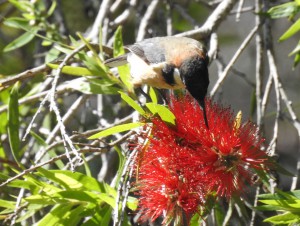
Caper white butterfly
Back to the main Wildlife Corridors page
Our primary selection of plants for wildlife corridors in he Scenic Rim are with squirrel gliders in mind, for reasons mentioned elsewhere on this site.
We would however like the corridors to benefit as many other native forest species as possible.
Accordingly we have selected a number of plants we think will assist a number of species.
You will see after downloading the pdf (below) that
- the first five columns tell which tees and shrubs provide nectar (especially inwinter, which is often the leanest month), sap/gum, hollow limbs for nesting (after 100 years or so of growth!) and tall vantage points from which to glide (after a few years’ growth).
- Next there is a column indicating whether the leaves are eaten by koalas,
- The next two indicate whether the nectar is eaten by nectarivorous birds (honeyeaters, silvereyes, lorikeets, rosellas and others) and other species, o

- whether they bear fruits eaten by frugivores (fruit-eating species, which may include birds, mammals and reptiles).
- The next three indicate provision of shelter for small ground-dwelling or ground-foraging creatures such as antechinus, bandicoots, echidnas, fairy-wrens babblers and lizards,
- This is followed by whether they provide nectar and pollen for native bees, or
- leaves for the caterpillars of local butterflies.
- Fire-retarding is next considered: there are no species that can withstand the very hottest of fires, but these are resistant to burning in “normal” fires, and could help slow down the spread of wildfire.
- Drought-resistance is next, as there may be times when it is difficult to keep up a water supply to thirsty young plants
- Finally, we want to prioritise species that are naturally found here in the Scenic Rim, or at least close by in SEQ
Click below for a downloadable pdf of possible plants:
Proposed Plant Species for Scenic Rim




